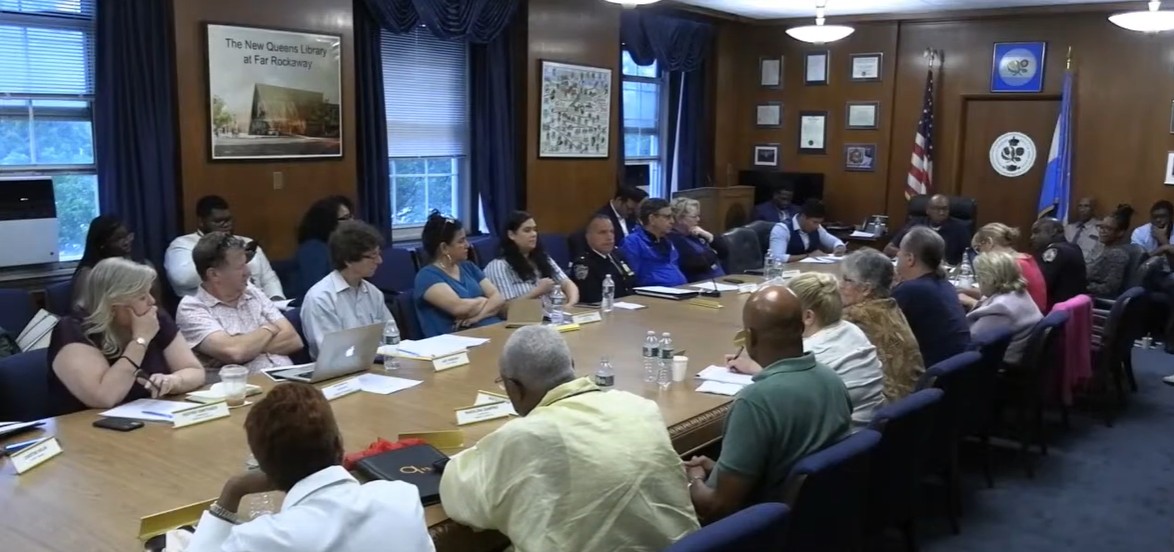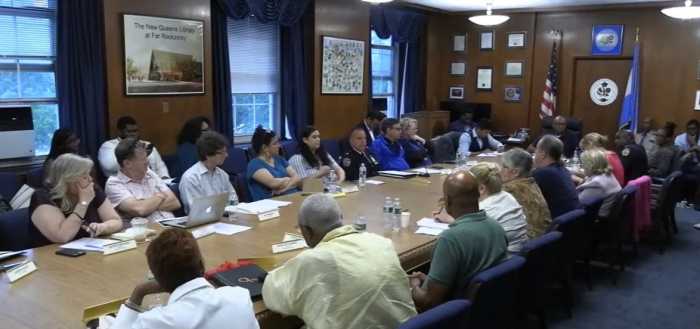Glick knocks nonpartisan plan
To The Editor:
The mayor’s proposal for abolishing party primary elections and replacing them with nonpartisan elections is wrongheaded. Mayor Bloomberg is following in Mayor Giuliani’s footsteps by convening a Charter Review Commission to propose hasty, undemocratic changes to the electoral process that will actually decrease voters’ voice in elections.
First and foremost, I believe that election reform must be handled in a democratic manner. There has been little opportunity for the public to participate in this debate. Members of the current commission represent a constituency of one. Most of the opinions expressed by the public at the few hearings held during the summer were blatantly ignored, while the radical changes that the mayor proposed were adopted with little debate among the commission members.
In addition, nonpartisan elections are rife with problems. Studies by political scientists have shown that cities that have adopted nonpartisan elections have experienced depressed voter-turnout rates. The last thing we need is fewer people voting. When fewer and fewer people are involved in choosing our elected officials, the gap between citizens and government increases. Furthermore, a diminution in the number of voting residents will weaken New York City’s voting power in state and national elections, thereby reducing the attention given to our needs and concerns in Albany and Washington.
Under the mayor’s proposal, candidates will not be required to disclose their party affiliations. In fact, a candidate will have the option of listing himself or herself as a candidate of any party, regardless of whether that candidate has earned the party’s support or is even a member of the party. By not requiring candidates to disclose their actual party affiliation, nonpartisan elections will take away a crucial consideration voters use in choosing a candidate. I see no reason to alter the charter simply to protect candidates who are reluctant to commit to positions on key issues. By eliminating the public’s right to know about a candidate’s views, we cede more and more power to moneyed interests that are not accountable to the public.
I am committed to working to improve elections in New York City. There are many legitimate reforms that can increase voter turnout that this administration has overlooked, such as lowering obstacles to voter registration and creating an expanded list of documents that first-time voters can use to prove their identity. In addition, it would be a great improvement if voters were correctly informed as to the location of their polling places.
The proposed changes to the city charter will be voted on by the public on Nov. 4 during an election anticipated to have a very low turnout. Even though my district typically has the highest turnout of any district in the state, some analysts are predicting low voter turnout in my district as well, since the three councilmembers whose districts overlap mine face little or no opposition. I will be voting No on Question 3 and will work hard to ensure high turnout in the 66th Assembly District both to elect strong councilmembers and to defeat this misguided change.
Deborah J. Glick
Glick is assemblymember for the 66th Assembly District
Lees: Out with the party bosses!
To The Editor:
As a lifelong Democrat, I’m excited to support nonpartisan elections. Nonpartisan elections level the playing field, open primary voting to all and will make our elections more inviting. As a Democrat, I believe our party should be at the forefront of progressive reforms and should be a vehicle for change, not a protector of the dreary, status quo — a system where party and union bossism have come to dominate and voter turnout is increasingly de minimus.
While elected officials of the Democratic Party are opposing nonpartisan elections, rank-and-file Democrats are open to the change. They see that nonpartisan elections will empower voters — and will only diminish the role of party bosses who use undue influence to control access to the ballot and who rely on an ever-shrinking pool of “prime” voters in pulling out the vote (only 12 percent of Democrats voted in the recent primary — that’s less than 4 percent of the entire New York City electorate).
Nonpartisan elections are nothing new. Eighty percent of American cities use them and New York City does too in the case of special elections (where voter turnout is always higher than in primary elections).
Nonpartisan elections simply mean two rounds of voting. In the first round, every voter, regardless of how they are registered to vote, gets to cast a ballot for any candidate of their choice. The top two vote-getters go on to the general election.
Nonpartisan elections mean we will have more competitive elections. Candidates will have to work harder to appeal directly to voters based on the issues and their merit. They won’t be able to take blocs of voters for granted and simply rely on the imprimatur of party bosses and party labels to make their case for them.
Under a nonpartisan system, political parties will continue to exist. Parties can raise money, endorse candidates, do voter registration drives, advocate for issues to their hearts’ content and conduct internal primaries of their own design. What nonpartisan elections do is simply end the undue influence of party and union bosses on the election process. It creates a level playing and that benefits the voters.
Democratic Party elected officials are trying to cast the push for nonpartisan elections as a “Republican takeover” attempt. But the debate about nonpartisan elections is not about Democrat versus Republican. It’s about the little guys (the voters) versus the party bosses.
Nonpartisan elections are a matter of fairness. All the taxpayers fund our election process and all the taxpayers should get to participate in each round of voting with an equal say.
The demographics of the city and the country are changing — not just racially, but politically. Thirty-five percent of Americans consider themselves independent. Over 40 percent of youth do too.
New York City has over 800,000 voters registered as “unaffiliated” (there are 2.2 million statewide) who currently have no say in the critical first round of voting. Forty percent of those unaffiliated voters in New York City are people of color who don’t want to be corralled into a political party before exercising their right to vote.
Let’s take our elections back and on Nov. 4 vote Yes on Question 3.
Aubrey Lees
Lees is a former Greenwich Village Democratic district leader
Goo-goos fear rocking the cradle
To The Editor:
Re “Brennan Center takes sides in nonpartisan debate” (news article, Oct. 22):
Your article on the Brennan Center’s opposition to a city charter revision that would move New York to a system of nonpartisan elections raises important issues on the role played by the good government establishment (the “goo-goos”) in our city.
Nonpartisan municipal elections are a basic good-government reform that has existed in most major U.S. cities since the beginning of the 20th century. It would be difficult, therefore, for Brennan and other goo-goos to take a position against it on the merits. Instead they argue that its proponents have not met their “burden of persuasion.” Brennan believes that the issue should not be put before the voters until there has been a “serious, methodologically defensible, empirical analysis of its probable impact,” the 100-year track record notwithstanding.
It does not take a study, however, for New Yorkers to decide if they prefer a system where all voters, regardless of party affiliation, can vote in the first round of elections for local offices. At present 1.5 million voters who are not registered Democrats are locked out of the Democratic Party primary, whose winner almost always prevails in the general election. It does not take a study to realize that something is wrong with a system where in the 2003 election for City Council only 141,000 people (3.5 percent of the electorate) voted in that primary.
Other goo-goos, like the leaders of NYPIRG, criticize the charter revision process as being dominated by the mayor and complain that they were not sufficiently consulted. Perhaps what they and Brennan are really concerned about is that their role as gatekeepers of political reform has been threatened.
Harry Kresky
Kresky is counsel to the New York State Independence Party and member of the People’s Coalition for Nonpartisan Elections. He served on the 2002 Charter Revision Commission.
.
Don’t blame Bobst
To The Editor:
Re “N.Y.U. library’s grand design didn’t include users’ safety” (Talking Point, by Allen Salkin, Oct. 22):
Allen Salkin’s opinion piece regarding the recent deaths at the N.Y.U. library left me speechless. Salkin seems to place all the blame for the suicides on the building’s design, making the claim that if Bobst Library wasn’t designed the way it is no one would have killed themselves.
I do not presume to know the reasons behind suicide, nor should Salkin. However, it seems ludicrous to me to believe that by simply altering a physical place where someone might kill himself, one can prevent him from doing so. Yes, closing off the balconies in Bobst will prevent people from jumping over the railing. However, will this really end suicides? Surely even Salkin has to admit that there are plenty of places left in New York City to kill onself; the very dorm room I am sitting in as I write this opens up to a courtyard eight stories below, and there are no barriers in the windows.
It is true that the Bobst atrium provides an opportunity for suicide. Regardless, simply focusing on preventing people from killing themselves there ignores the real problem. The N.Y.U. community needs to focus on addressing the causes of suicide rather than just putting up Plexiglas barriers in hopes that they will solve everything.
In his piece, Salkin sounds angry, and rightly so. No one goes away unaffeccted by a suicide; no one should remain complacent about such tragic events. However, his anger is misplaced. It is not the fault of Philip Johnson and the atrium he designed that these students decided to take their own lives. And to continue to adopt this single-minded approach towards understanding these suicides only risks allowing future deaths.
Ryan Gee
Gee is a junior at New York University
League’s dubious record
To The Editor:
Re: “Lopez gets an F on environment” (news article, Oct. 22):
I am writing this letter to give readers accurate information, which should have been the responsibility of The Villager.
Less than five minutes on the New York League of Conservation Voters’ Web site shows the true story. First, L.C.V. convened a task force of leading environmental and civic organizations to identify important legislation — Who is on the task force? Why aren’t these members identified on the Web site? Why the secrecy?
L.C.V. is tracking 11 bills to rank councilmembers. Most organizations identify voting records. Of the 11 bills being tracked, two have come to the council for a vote. Not only Councilmember Lopez, but 100 percent of the councilmembers voted for these bills. So she and all the members have a 100 percent voting record on environmental legislation. This is reason for congratulations — no?
Many of the remaining bills have not even had public hearings. Maybe some councilmembers need to hear pros and cons from their constituents and experts before weighing in on a bill. (Maybe they are more responsive to their communities than to L.C.V.)
Signing on to many of these bills wouldn’t necessarily make a difference in getting them passed, as shown by Speaker Miller’s refusal to allow a vote on the most important lead-poisoning bill, even though a majority of councilmembers as well as advocates and community organizations have formally expressed support.
It is particularly ironic that Intro 0030 — to reduce emissions from power plants — has been identified. L.C.V. knows that plant emissions are determined by state legislation. And L.C.V. has honored Governor Pataki as an environmental governor, even though he refuses to allow legislation that would lower emissions and continues to allow siting of these plants in low-income communities of color. Where has L.C.V. been when our communities were fighting for clean air and a responsible state energy plan? I have not seen them around. I do remember joining environmental activists picketing the L.C.V. dinner honoring Governor Pataki as an environmental governor.
However, Councilmember Lopez was a strong participant in the community’s battle against Con Ed for clear air in our community. She is continuing to fund and fight for issues in our community regarding diesel emissions. This is not reflected in the L.C.V. evaluation.
I give L.C.V. an “F” for inaccurate reporting and for lack of support in the fight for clean air and a responsible energy plan and for fair share for communities overburdened by noxious and environmentally damaging facilities and for being self-serving at the expense of environmental justice in honoring Pataki. I want to be clear that I am writing this as an individual — but it is from a perspective as an environmental activist in the community.
Susan Stetzer
Stetzer is former vice president of East River Environmental Coalition, which fought Con Ed’s expansion of its E. 14th St. plant, and chairperson of Community Board 3’s Public Safety Committee, which handles environmental issues.
Will the show go on?
To The Editor:
We sure have been hearing a lot about Pier 40 these days.
We hear about Greenwich Village Little League, P3, soccer, New York Kayak, Floating the Apple and the dog run. We hear about the Friends of Hudson River Park and the new proposal for the covered ice rink. We are assured that the FedEx and the bus company and all the other big trucks will be required to give up their tenancy as of Dec. 31, 2003.
I guess I am feeling a bit left out. Of course, that has mostly been by choice. Biz Kids NY is a theater school with a very neat theater on the south side of Pier 40. We are one of the most respected schools teaching acting, singing and dancing to young people aged 7 to 67. We are a legitimate use on the pier in both the areas of education and the arts.
I just want to let the community realize we are there and we have over 240 families from our West Village to all over the tri-state area and farther. We are there, we hope to stay there and look forward to the Hudson River Trust signing a contract with us to stay on. We offer the finest training in Lecoq, Grotowski, commedia del’arte, clown, mask, mime and script from Aristophanes to Shakespeare and Mamet. We work on film and have many of our young people in film, commercials and TV series. Our work is serious art education for young people.
Please give us your support so we in the West Village and certainly in New York have a center for fine education in the arts for our kids.
Peggy Lewis
Lewis is director, Biz Kids NY
Model of unselfishness
To The Editor:
In an age where character education is critical in shaping the future of our youth, I would like to recognize a modern day hero: Marcus Centeno of Brooklyn, NY.
Centeno, a crisis interventionist at The Lorge School on W. 17th St. in Manhattan, accompanied my class on a recent field trip. Upon exiting the L Train, our group noticed a man stranded in a wheelchair, trying to no avail to negotiate a defunct elevator. Assuming there was nothing we could do, our group proceeded up the stairs. Without audience or fanfare, Centeno, who is asthmatic, lifted the man and the chair and carried him up three full flights of stairs from the bowels of the subway system. With only a brief pause to recharge his lungs with his asthma pump, Centeno brought the man to safety and enabled the stranger to continue on with his agenda.
My students witnessed this unselfish and heroic modeling after realizing what had just happened. They are indelibly impacted by such a positive example.
May Marcus Centeno be recognized as New Yorker of the Week!
Denise Petrillo
Petrillo is a teacher at The Lorge School






































